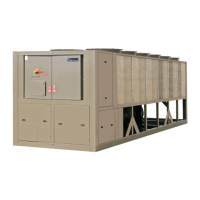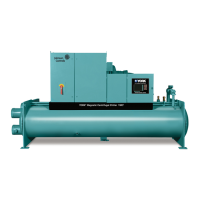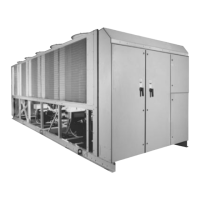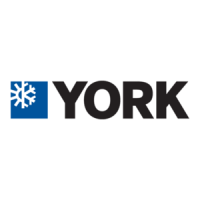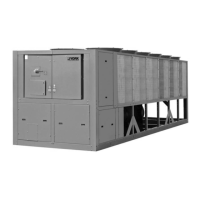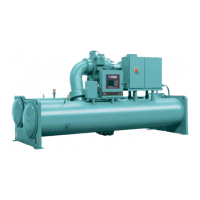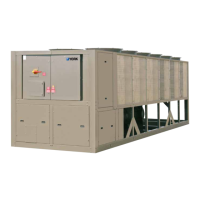Do you have a question about the York R123 and is the answer not in the manual?
Explains the meaning of safety symbols used throughout the document.
Describes the chiller's operational flow and system components.
Details the mechanism for controlling chiller capacity using prerotation vanes.
Provides an overview of the OptiView Control Center and its functions.
Details the layout and functionality of the OptiView Control Center display and keypad.
Explains the general conventions used for displaying information and user interaction.
Describes the default display upon chiller startup, showing primary monitored parameters.
Provides a general overview of common chiller parameters for both shells.
Displays evaporator-related setpoints and provides a cutaway view of the evaporator.
Shows condenser-related setpoints and offers a cutaway view of the condenser.
Displays the status of the Purge Tank, float switches, and solenoids.
Details liquid refrigerant level control and variable orifice position.
Presents a cutaway view of the compressor, showing its operating parameters.
Displays hot gas bypass valve position and related control parameters.
Shows parameters related to the surge protection feature for the compressor.
Allows calibration of the pre-rotation vanes for VSD or Hot Gas Bypass applications.
Details tuning parameters for the Variable Speed Drive and manual vane control.
Displays a close-up view of the chiller oil sump and related parameters.
Provides information specific to the Electro-Mechanical Starter.
Details information pertaining to the Mod "A" Solid State Starter.
Details information pertaining to the Mod "B" Solid State Starter.
Displays general information related to the Variable Speed Drive (VSD).
Offers more detailed information about the Variable Speed Drive (VSD).
Provides detailed information on the Adaptive Capacity Control (ACC) feature.
Shows detailed information regarding the IEEE-519 Harmonic Filter.
Offers a central location for programming common chiller setpoints.
Allows configuration of general system parameters like time, date, and language.
Enables definition of custom User IDs, passwords, and access levels.
Allows definition of necessary communication parameters for printers and serial ports.
Configures necessary communication parameters for the printer.
Allows definition of sales order parameters, entered at commissioning.
Defines general parameters related to chiller operation.
Allows browsing through fault logs and system shutdowns.
Displays an on-screen printout of system parameters at the time of a selected shutdown.
Displays a listing of the last 75 setpoint changes.
Allows plotting of selected parameters in an X/Y graph format.
Used to configure the trending screen parameters and data collection.
Sets up data collection start/stop triggers based on digital events or analog parameters.
Displays slot numbers for commonly monitored parameters for trending.
Allows selection of up to 10 parameters for display on the Custom View Screen.
Lists compatible printers and provides guidelines for using unlisted printers.
Details the configuration steps required for selected printers.
Explains how to connect printers to the Control Center Microboard.
Outlines the necessary Control Center settings for printer communication.
Explains the function and operation of the oil heaters.
Details the procedure for checking and maintaining the oil level in the reservoir.
Provides step-by-step instructions for starting up the chiller.
Describes how the chiller operates, including capacity control and vane modulation.
Explains the control of condenser water temperature for optimal chiller performance.
Outlines periodic checks to ensure proper chiller operation.
Emphasizes the importance of maintaining a daily record of operating conditions.
Provides a list of daily, weekly, and quarterly inspections for optimal chiller performance.
Details the procedure for shutting down the chiller for extended periods.
Outlines the steps for restarting the chiller after a prolonged shutdown.
Describes the construction and material of the compressor casing.
Details the components and design of the compressor rotor assembly.
Explains the types of bearings used in the compressor assembly.
Describes the design and function of the internal gears.
Explains the oil system for lubricating compressor bearings and gears.
Describes the function of prerotation vanes in modulating chiller capacity.
Details the construction and material of the compressor shaft seal.
Describes the open motor used with the compressor, including types and construction.
Explains the construction and provisions of the motor terminal box.
Details the entire chiller lubrication system, including oil pump, filter, and cooler.
Explains the operation of the oil pump, including manual and automatic modes.
Describes the function of the oil heater in preventing oil foaming.
Details the construction of the cooler and condenser shells.
Describes the type and installation of the heat exchanger tubes.
Explains the construction and features of the water boxes.
Describes the cooler's design, distribution system, and refrigerant sight glass.
Details the condenser's design, baffles, and purge connection.
Explains the refrigerant flow control mechanism and bursting disc.
Describes the function and availability of the Solid State Starter.
Details the function and operation of the Variable Speed Drive.
Explains the function of the oil return system in maintaining compressor oil levels.
Details how the oil return system maintains proper oil level in the compressor sump.
Provides step-by-step instructions for changing the dehydrator.
Explains the procedure for charging the compressor oil reservoir.
Details the steps for charging oil using the YORK Oil Charging Pump.
Refers to forms for ordering required renewal parts.
Describes procedures for testing the system for refrigerant leaks.
Explains how to perform leak tests while the system is operational.
Details the procedure for conducting a pressure test after refrigerant charge removal.
Outlines the owner's responsibility for daily, monthly, and yearly maintenance.
Details maintenance procedures for the compressor assembly, including oil filter and windings.
Specifies when to change the oil filter based on operating hours and pressure drops.
Covers inspection of electrical controls and RTC battery replacement.
Details checks for motor mounting screws and winding megger tests.
Emphasizes annual pressure testing to detect and repair leaks.
Covers maintenance of the water side of the cooler and condenser.
Details procedures for maintaining the purge unit, including dehydrator changes.
Outlines semi-annual replacement of the oil return system dehydrator.
Covers inspection of electrical controls and checking the RTC battery.
Explains the meaning of safety symbols used throughout the document.
Describes the chiller's operational flow and system components.
Details the mechanism for controlling chiller capacity using prerotation vanes.
Provides an overview of the OptiView Control Center and its functions.
Details the layout and functionality of the OptiView Control Center display and keypad.
Explains the general conventions used for displaying information and user interaction.
Describes the default display upon chiller startup, showing primary monitored parameters.
Provides a general overview of common chiller parameters for both shells.
Displays evaporator-related setpoints and provides a cutaway view of the evaporator.
Shows condenser-related setpoints and offers a cutaway view of the condenser.
Displays the status of the Purge Tank, float switches, and solenoids.
Details liquid refrigerant level control and variable orifice position.
Presents a cutaway view of the compressor, showing its operating parameters.
Displays hot gas bypass valve position and related control parameters.
Shows parameters related to the surge protection feature for the compressor.
Allows calibration of the pre-rotation vanes for VSD or Hot Gas Bypass applications.
Details tuning parameters for the Variable Speed Drive and manual vane control.
Displays a close-up view of the chiller oil sump and related parameters.
Provides information specific to the Electro-Mechanical Starter.
Details information pertaining to the Mod "A" Solid State Starter.
Details information pertaining to the Mod "B" Solid State Starter.
Displays general information related to the Variable Speed Drive (VSD).
Offers more detailed information about the Variable Speed Drive (VSD).
Provides detailed information on the Adaptive Capacity Control (ACC) feature.
Shows detailed information regarding the IEEE-519 Harmonic Filter.
Offers a central location for programming common chiller setpoints.
Allows configuration of general system parameters like time, date, and language.
Enables definition of custom User IDs, passwords, and access levels.
Allows definition of necessary communication parameters for printers and serial ports.
Configures necessary communication parameters for the printer.
Allows definition of sales order parameters, entered at commissioning.
Defines general parameters related to chiller operation.
Allows browsing through fault logs and system shutdowns.
Displays an on-screen printout of system parameters at the time of a selected shutdown.
Displays a listing of the last 75 setpoint changes.
Allows plotting of selected parameters in an X/Y graph format.
Used to configure the trending screen parameters and data collection.
Sets up data collection start/stop triggers based on digital events or analog parameters.
Displays slot numbers for commonly monitored parameters for trending.
Allows selection of up to 10 parameters for display on the Custom View Screen.
Lists compatible printers and provides guidelines for using unlisted printers.
Details the configuration steps required for selected printers.
Explains how to connect printers to the Control Center Microboard.
Outlines the necessary Control Center settings for printer communication.
Explains the function and operation of the oil heaters.
Details the procedure for checking and maintaining the oil level in the reservoir.
Provides step-by-step instructions for starting up the chiller.
Describes how the chiller operates, including capacity control and vane modulation.
Explains the control of condenser water temperature for optimal chiller performance.
Outlines periodic checks to ensure proper chiller operation.
Emphasizes the importance of maintaining a daily record of operating conditions.
Provides a list of daily, weekly, and quarterly inspections for optimal chiller performance.
Details the procedure for shutting down the chiller for extended periods.
Outlines the steps for restarting the chiller after a prolonged shutdown.
Describes the construction and material of the compressor casing.
Details the components and design of the compressor rotor assembly.
Explains the types of bearings used in the compressor assembly.
Describes the design and function of the internal gears.
Explains the oil system for lubricating compressor bearings and gears.
Describes the function of prerotation vanes in modulating chiller capacity.
Details the construction and material of the compressor shaft seal.
Describes the open motor used with the compressor, including types and construction.
Explains the construction and provisions of the motor terminal box.
Details the entire chiller lubrication system, including oil pump, filter, and cooler.
Explains the operation of the oil pump, including manual and automatic modes.
Describes the function of the oil heater in preventing oil foaming.
Details the construction of the cooler and condenser shells.
Describes the type and installation of the heat exchanger tubes.
Explains the construction and features of the water boxes.
Describes the cooler's design, distribution system, and refrigerant sight glass.
Details the condenser's design, baffles, and purge connection.
Explains the refrigerant flow control mechanism and bursting disc.
Describes the function and availability of the Solid State Starter.
Details the function and operation of the Variable Speed Drive.
Explains the function of the oil return system in maintaining compressor oil levels.
Details how the oil return system maintains proper oil level in the compressor sump.
Provides step-by-step instructions for changing the dehydrator.
Explains the procedure for charging the compressor oil reservoir.
Details the steps for charging oil using the YORK Oil Charging Pump.
Refers to forms for ordering required renewal parts.
Describes procedures for testing the system for refrigerant leaks.
Explains how to perform leak tests while the system is operational.
Details the procedure for conducting a pressure test after refrigerant charge removal.
Outlines the owner's responsibility for daily, monthly, and yearly maintenance.
Details maintenance procedures for the compressor assembly, including oil filter and windings.
Specifies when to change the oil filter based on operating hours and pressure drops.
Covers inspection of electrical controls and RTC battery replacement.
Details checks for motor mounting screws and winding megger tests.
Emphasizes annual pressure testing to detect and repair leaks.
Covers maintenance of the water side of the cooler and condenser.
Details procedures for maintaining the purge unit, including dehydrator changes.
Outlines semi-annual replacement of the oil return system dehydrator.
Covers inspection of electrical controls and checking the RTC battery.
| Compressor Type | Centrifugal |
|---|---|
| Refrigerant | R-123 |
| Cooling Capacity | Varies by model |
| Efficiency | Varies by model |
| Sound Level | Varies by model |
| Voltage | Varies by model |
| Dimensions | Varies by model |
| Weight | Varies by model |
